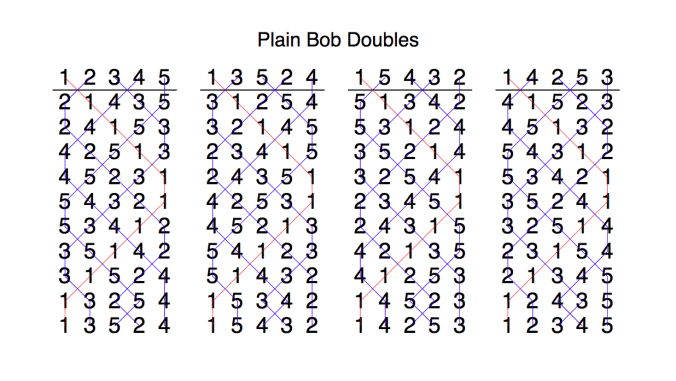24: Coursing order in Bob Doubles
Lesson under construction.
Coursing order can be a big help in staying right in a piece of ringing. Let's imagine that you're ringing the 3rd to a plain course of Plain Bob Doubles. The coursing order is 5324.
The first two thgings to notice are that:
- Your course bell is the 5th.
- Your after bell is the 2nd.
Your course bell (5th) is the one that you follow round the method. That means that:
- You will always hunt down behind the 5th
- You will always lead immediately after the 5th
- When you hunt up, the 5th will be above you and you will meet 5th at the back of the row when you get there (i.e. you follow the 5th for your first blow at the back)
Your after bell (2nd) is the bell that follows you round. This means that:
- The 2nd will always be the bell to follow as you leave the front.
- You will always be higher than the 2nd as you hunt up to the back
- The 2nd will always arrive at the back as you are about to leave (i.e. you follow the 2nd for your second blow at the back)
I'm not suggesting that you try and remember all this. Simply be aware of the fact that you have a course bell and an after bell and try to look out for them, particularly at the front and at the back of the row.
The one fly in the ointment is the treble. Remember that, because it follows its own simp-ler path, the treble moves through the coursing order and will, from time to time come between you and your course bell or your after bell. Because a piece of work like a dodge or four blows behind delays you by a whole pull relative to the treble, you will find that you pass the treble a blow later in each lead of Bob Doubles. It's easiest to see this by ringing the 2nd. At the start of the plain course, you immediately pass the treble in 2-1 (i.e. as you hunt from 2nds place to lead). The next lead (after your 3-4 down dodge), you pass it in 3-2 (immediately after the dodge in fact). In the third lead, you pass it in 4-3, and in the final lead, in 5-4. In the last lead, the treble courses down behind you and turns you from lead, so you make 2nds.
The fact that you pass the treble in a different place in each lead suggests that it might be a good idea to learn what happens after you pass the treble in 2-3 on the way up for instance. A lot of people use this approach, but I don't recommend it. I see it as simply another set of rules to remember, to muddle up and to forget in the heat of the moment. Remember that all four pieces of work in Bob Doubles happen only when the treble is leading. In one lead of the four, the one where the treble courses you down from the back, it's particularly easy to see when that is, because the treble turns you from lead (so you make 2nds). It's also easy enough to see where the treble is when you turn it from the back and course down behind it. It's in front of you and will lead as you arrive in 3rds place; that means you need to dodge (3-4 down). There's another pretty easy place to see the treble: if you pass it in 2-3 as you're hunting up, the treble must be about to lead. That means it's time for a dodge (3-4 up).
Have another look at the plain course of Bob Doubles and see if you can see how all those points above work. When you're ringing it, be aware of your course and after bells, and keep an eye on the treble.

So, which bell is your course bell and which is your after bell? Remember that the coursing order just cycles round and round, so the bells arrive at the back and at the front in the order 5324532453245324 etc, the only exception being when the treble gets in the way. From this, you should be able to read off course and after bells for each of the working bells. They are:
| Bell | Course bell | After bell |
| 2nd | 3rd | 4th |
| 3rd | 5th | 2nd |
| 4th | 2nd | 5th |
| 5th | 4th | 3rd |
Ringing touches
This table is only true for as long as you remain in the plain course. If the conductor calls a bob, you will find that either your course bell or your after bell or even both will change. Don't panic. Just keep ringing and look to see who your new course and after bells are, remembering that you meet them at the front and at the back of the row. They will stay the same, until another bob is called. In a 120 of Bob Doubles, there are three bobs. After the third bob, you will find yourself back in the plain course and the touch will run round. Just be aware that some conductors like to chuck bobs around left, right and centre just to confuse evrybody, The resulting touch is almost invariably false (which may or may not bother you); be aware that your course and after bells will change quite a lot in such extravaganzas. There are actually very few true touches of Bob Doubles. They are:
20: bb
60: bp x3
100: bpbpp x 2
120: pppb x 3
The 60s, 100s and 120s can be rotated by starting at any point, giving two possible 60s, five possible 100s and 4 possible 120s.



